MIST
Magnetosphere, Ionosphere and Solar-Terrestrial
Nuggets of MIST science, summarising recent papers from the UK MIST community in a bitesize format.
If you would like to submit a nugget, please fill in the following form: https://forms.gle/Pn3mL73kHLn4VEZ66 and we will arrange a slot for you in the schedule. Nuggets should be 100–300 words long and include a figure/animation. Please get in touch!
If you have any issues with the form, please contact This email address is being protected from spambots. You need JavaScript enabled to view it..
Long-term Correlations of Polytropic Indices with Kappa Distributions in Solar Wind Plasma near 1 AU
by Georgios Nicolaou (MSSL, UCL)
The polytropic process determines a relationship between the plasma density and temperature, during the transition of the plasma from one equilibrium state to another under constant specific heat. This process is described by the effective polytropic index, which can be determined by the analysis of plasma density and temperature measurements, and is a crucial parameter in determining the dynamics of the plasma.
Over the last few decades numerous studies have shown that the velocities of the plasma particles often follow kappa distribution functions. The kappa index that labels and governs these distributions also becomes a key parameter to understand the plasma dynamics.
Interestingly, recent studies have shown that the polytropic indices and kappa indices of space plasmas are related, in the presence of potential energy. Moreover, the relationship between the two indices defines the potential degrees of freedom.
This is the first statistical study to analyze Wind spacecraft observations to derive the polytropic index and the kappa index of solar wind protons and investigate their relationship, over the last two solar cycles. We show that, most of the time, the two indices are related, exactly as predicted by the theory. When able, we quantify the relation in order to derive the potential degrees of freedom. Among others, we show that an enhanced solar activity and/or interplanetary magnetic field, reduces the potential degrees of freedom, and decrease the dimensionality of a typical electric field potential from dr = 3 in solar minimum, to dr = 2 in solar maximum (Figure 1).
Overall, these results identify fundamental properties of the solar wind plasma, that demonstrate clear dependences on solar cycle.
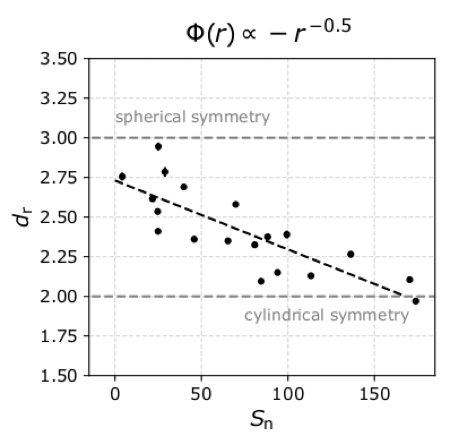
Figure 1. Dimensionality dr for a typical interplanetary potential as a function of sunspot number Sn. The linear fit to data points (black dash) is also shown. The results indicate that the potential dimensionality dr reduces with increasing Sn.
For more information, please see the paper:
Nicolaou G. and G. Livadiotis (2019). Long-term correlations of polytropic indices with Kappa distributions in solar wind plasma near 1 AU. The Astrophysical Journal, 884:52, https://iopscience.iop.org/article/10.3847/1538-4357/ab31ad/meta
The Variation of Geomagnetic Storm Duration with Intensity
By Carl Haines (University of Reading)
Variability in the near-Earth solar wind conditions can adversely affect a number of ground- and space-based technologies. Some of these space weather impacts on ground infrastructure are expected to increase primarily with geomagnetic storm intensity, but also storm duration, through time-integrated effects. Forecasting storm duration is also necessary for scheduling the resumption of safe operating of affected infrastructure. It is therefore important to understand the degree to which storm intensity and duration are related.
In this study, we use the recently recalibrated aa index, aaH, which provides a global measure of the level of geomagnetic disturbance. We analyse the relationship between geomagnetic storm intensity and storm duration over the past 150 years, further adding to our understanding of the climatology of geomagnetic activity. In particular, we construct and test a simple probabilistic forecast of storm duration based on storm intensity. Using a peak-above-threshold approach to define storms, we observe that more intense storms do indeed last longer but with a non-linear relationship (See Figure 1a).
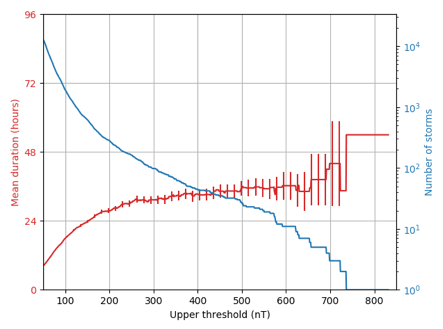
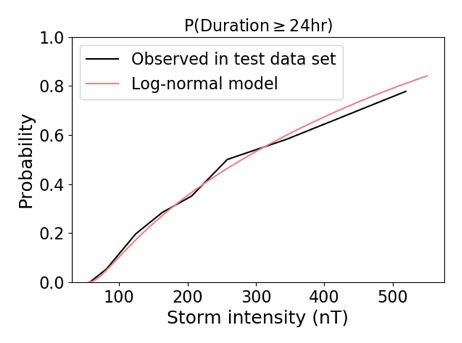
Figure 1 (a) The mean duration (red) and number of storms (blue) plotted as a function of storm intensity. (b) The probability that a storm will last at least 24 hours plotted as a function of storm intensity. The black line shows the observed probability and the red line shows the model output.
Next, we analysed the distribution of storm durations in different intensity classes. We found them to be approximately lognormal, with parameters depending on the storm intensity. On this basis we created a method to probabilistically predict storm duration given peak intensity. Equations are given to find lognormal parameters as a function of storm peak intensity. From these, a distribution of duration can be created and hence a probabilistic estimate of the duration of this storm is available. This can be used to predict the probability a storm will last at least e.g. 24 hours. Figure 1b shows the output of the model for a range of storm peak intensity compared against a test set of the aaH index. The model has good agreement with the observations and provides a robust method for estimating geomagnetic storm duration. The results demonstrate significant advancements in not only understanding the properties and structure of storms, but also how we can predict and forecast these dynamic and hazardous events.
For more information, please see the paper:
Haines, C., Owens, M.J., Barnard, L. et al. Sol Phys (2019) 294: 154. https://doi.org/10.1007/s11207-019-1546-z
Cassini’s Grand Finale:- Planetary Period Oscillations are everywhere and the dayside field ‘lags’
by Gabby Provan (University of Leicester)
Saturn’s Planetary Period Oscillations are oscillations at close to Saturn’s planetary period which have been observed to organize all of Saturn’s ionospheric and magnetospheric parameters throughout the Cassini mission. There are two oscillatory systems, one in the Northern hemisphere and one in the Southern. The enduring mystery is that so far we have yet to understand how a perfectly axisymmetric planetary magnetic field can create such oscillations
In this paper, we study the magnetic field throughout the Cassini Grand Finale orbits. On these orbits Cassini passed from the northern auroral region in the dawn sector, through the gap between the D ring inner edge and Saturn’s atmosphere, and outbound to the southern auroral region in the dusk sector (See Figure 1). We observe dual PPO modulations on auroral, subauroral, ring-region and intra-ring region field lines – in other words everywhere (see Figure 2). This is the first time that PPOs have been observed on and inside ring region field lines. The presence of such field perturbations may provide an explanation for apparent PPO-related phenomena observed in the ring material itself, through the action of these fields on charged dust grains (see e.g. Chancia et al., 2019).
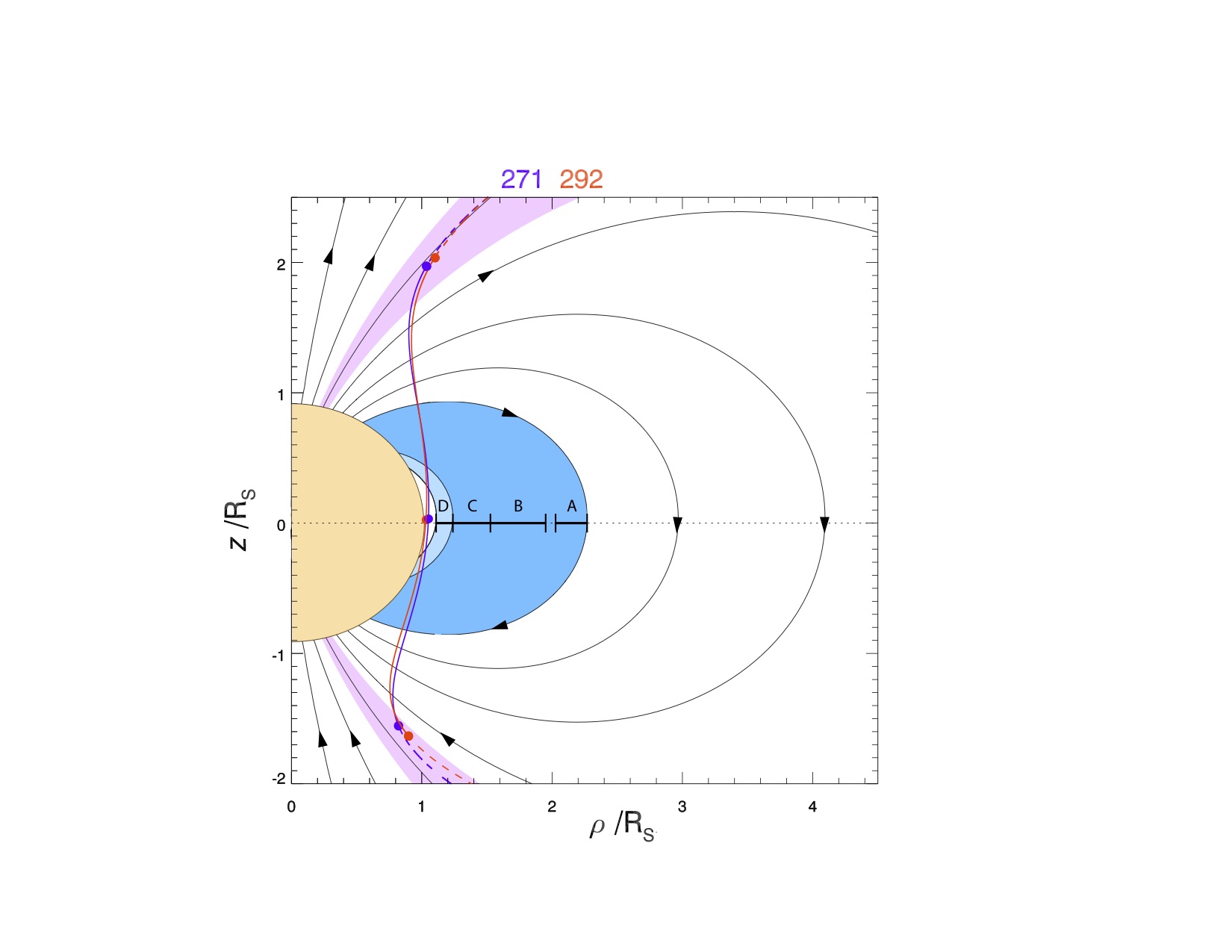
Figure 1: Plot of the periapsis pass trajectories of the initial and final proximal orbits, Revs 271 (blue) and 292 (red), projected into a meridian plane in cylindrical coordinates. The darker blue field-aligned area corresponds to field lines mapping through the main ring region in the equatorial plane, between the inner boundary of the C ring and the outer boundary of the A ring, while the lighter blue field-aligned area corresponds to field lines mapping through the D ring.
Next, we considered the residual magnetic field, having discounted the magnetic signature of the PPOs and Saturn’s ring current from the observed magnetic field observations. We found that the residual azimuthal field had a lagging configuration in the subauroral region with a magnitude ~3-5 nT. These fields extend essentially unmodified inwards, crossing the ring region and the field lines mapping to Saturn synchronous orbit, to the outer boundary of D ring field lines. The lagging field indicates a field-aligned current flow of ~0.25 MA rad-1 flowing from the southern ionosphere toward the C and inner B rings. The physical origin of the extended region of lagging dayside fields remains unclear.
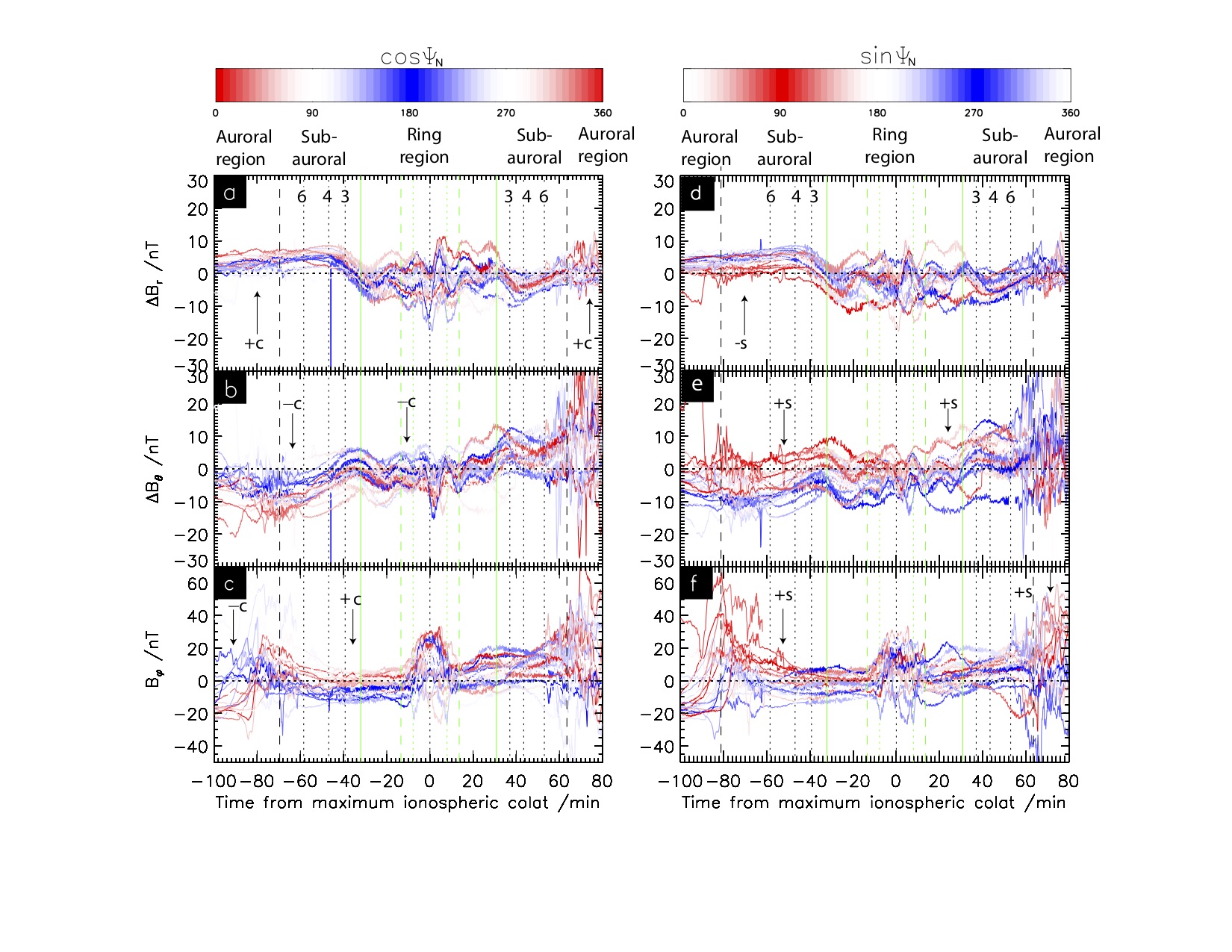
Figure 2: Field data from all the proximal orbit periapsis passes, color-coded according the northern PPO system phase. The data are plotted versus time from their field-parallel points taken as t = 0 (central vertical black dotted line), over the interval between -100 and +80 min, Vertical dashed lines indicate the equatorward boundary of the auroral region. The green solid lines mark the field line passing through the outer boundary of the A ring, while the green dashed and dotted lines mark the field lines passing through the outer and inner boundaries of the D ring, respectively. Data in Figures 2a-2c on the left are color-coded by northern PPO phase such that phases near 0°-360° are colored red and phases near 180° blue. Similarly, data in Figures 2d-2f on the right are color-coded by northern PPO phase such that phases near 90° are colored red and phases near 270° blue.
For more information, please see the paper:
Provan, G., Cowley, S. W. H., Bradley, T. J., Bunce, E. J., Hunt, G. J., Cao, H., & Dougherty, M. K. ( 2019). Magnetic field observations on Cassini's proximal periapsis passes: Planetary period oscillations and mean residual fields. Journal of Geophysical Research: Space Physics, 124. https://doi.org/10.1029/2019JA026800
Effects of VLF transmitter waves on the inner belt and slot region
by Johnathan Ross (British Antarctic Survey)
Signals from man made VLF (Very Low Frequency) transmitters can leak from the Earth-ionosphere wave guide into the inner magnetosphere, where they propagate as electromagnetic waves and contribute to electron dynamics in the inner radiation belt and slot region. These waves are highly localised around the transmitters and are strongest on the nightside. It has been suggested that these waves may be responsible for removing the hazardous MeV energy electrons from this region that can be extremely damaging to satellites. The VLF transmitter waves scatter electrons in pitch angle (the angle between the background field and electron velocity). In an average sense, this scattering can be represented by a diffusion equation, with a diffusion coefficient that can be calculated using quasi-linear theory. In this study we use ~5 years of Van Allen Probesobservations to construct global statistical models of the diffusion coefficients for each individual VLF transmitter, as a function of L*, Magnetic Local Time (MLT) and geographic longitude.
These diffusion coefficients are then incorporated into a 1D pitch-angle diffusion model with longitude and MLT dependence. We find that global averages of the wave power capture the long-term dynamics of the loss process, despite the highly localised nature of the waves in space. We use our model to assess the role of VLF transmitter waves compared to other important loss processes (hiss waves and coulomb collisions) on electron loss in the inner radiation belt and slot region. The figure shows the decay timescales as a function of L value for different combinations of the VLF transmitter (T), coulomb collisions (C), and hiss wave (H) processes. At moderate relativistic energies, E~500 keV (panel d), waves from VLF transmitters have a significant role! They reduce electron lifetimes by an order of magnitude or more, down to the order of 200 days near the outer edge of the inner radiation belt. However, VLF transmitter waves are ineffective at removing multi-MeV electrons (panel f) from either the inner radiation belt or slot region. The results suggest that although the VLF transmitters are important for radiation belt loss, they cannot be responsible for removing the dangerously high energy electrons from the region occupied by satellites.
For more information, please see the paper:
Ross, J. P. J., Meredith, N. P., Glauert, S. A., Horne, R. B., & Clilverd, M. A. ( 2019). Effects of VLF transmitter waves on the inner belt and slot region. Journal of Geophysical Research: Space Physics, 124, 5260– 5277. https://doi.org/10.1029/2019JA026716
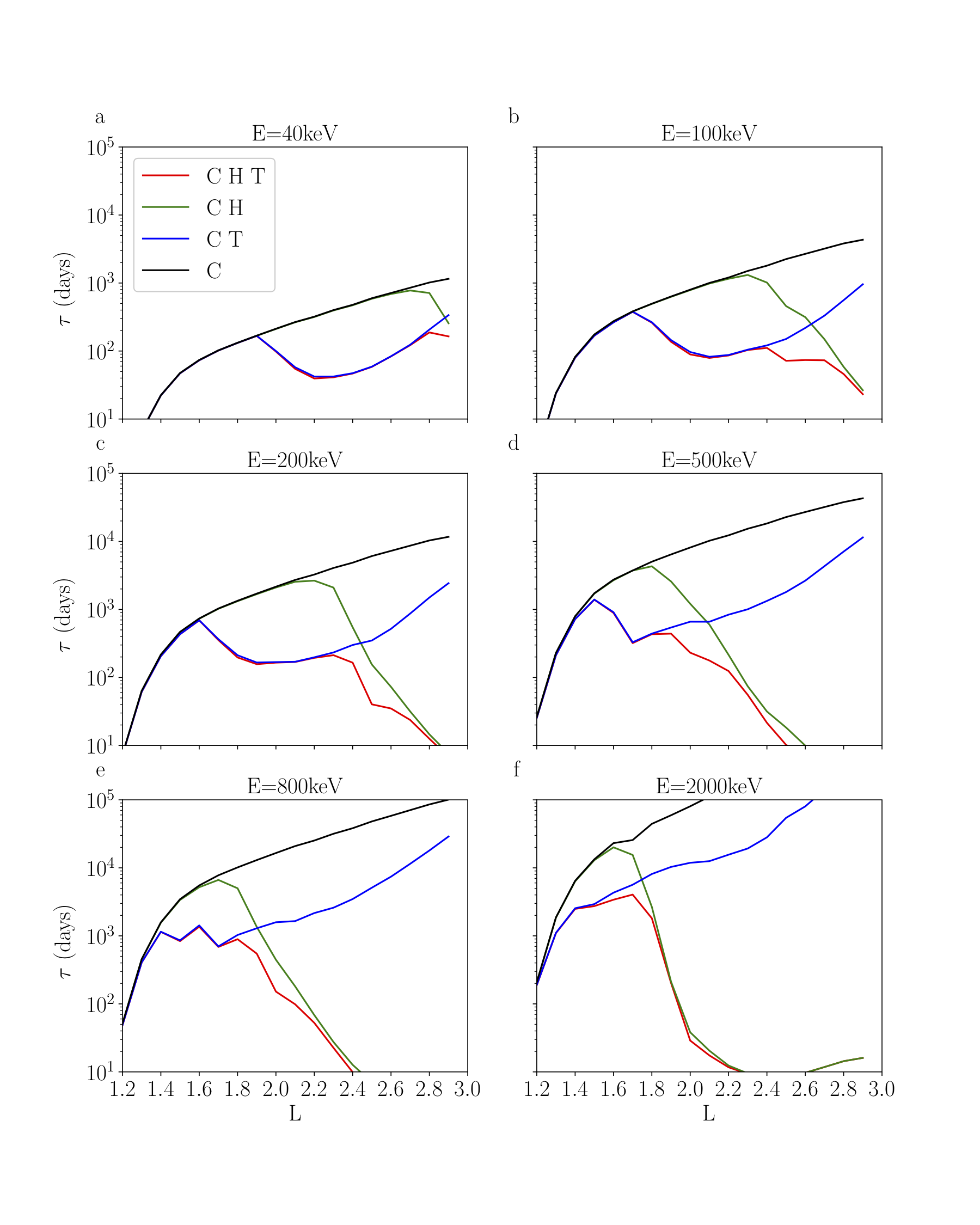
Figure: Electron decay timescales from the 1D model with MLT and longitude averaging. The lines correspond to: black - Coulomb collisions; green - hiss and Coulomb collisions; blue - VLF transmitters and Coulomb collisions; red - VLF transmitters, hiss and Coulomb collisions.
How does substorm activity affect the ring current?
by Jasmine Kaur Sandhu (MSSL, UCL)
Earth’s magnetosphere is highly dynamic and due to coupling with the solar wind huge amounts of energy can be stored in the stretched magnetotail. Substorms (impulsive bursts of nightside reconnection) rapidly close large amounts of the tail flux and, through enhanced convection and injection of plasma, substorms can significantly energise the ring current population.
Do substorms with different properties affect the ring current differently?
Substorms can occur as an isolated event (preceded and followed by quiet periods) or as part of a compound event (multiple substorms occurring one directly after the other). A statistical analysis of ion observations from the Van Allen Probes was conducted to identify the similarities and differences in the ring current population during isolated substorms and the first compound substorm in a sequence. Figure a,b,d,e shows L-MLT maps of the median ring current energy content for both isolated and compound substorms, as well as before substorm onset (growth phase) and after substorm onset (expansion phase). Figure c,f shows statistically significant changes following onset and Figure g,h shows the difference in energy content for compound substorms compared to isolated.
Both types of substorms are associated with an enhancement post-onset, where the total enhancement is larger for a compound substorm. We also observed that the ring current energy content is elevated during compound substorms compared to isolated substorms, both before and after onset. Analysis shows that a key driver of these differences is the enhanced and prolonged solar wind driving prior to onset of compound substorms. Plasma is more effectively circulated to the inner magnetosphere and the density of injections are increased.
Overall the work demonstrates the importance of solar wind driving for the substorm – ring current relationship and suggests that compound substorms are able to very effectively energise the ring current to a high degree.
For more information, please see the paper:
Sandhu, J. K., Rae, I. J., Freeman, M. P., Gkioulidou, M., Forsyth, C., Reeves, G. D., et al. (2019). Substorm‐ring current coupling: A comparison of isolated and compound substorms. Journal of Geophysical Research: Space Physics, 124. https://doi.org/10.1029/2019JA026766
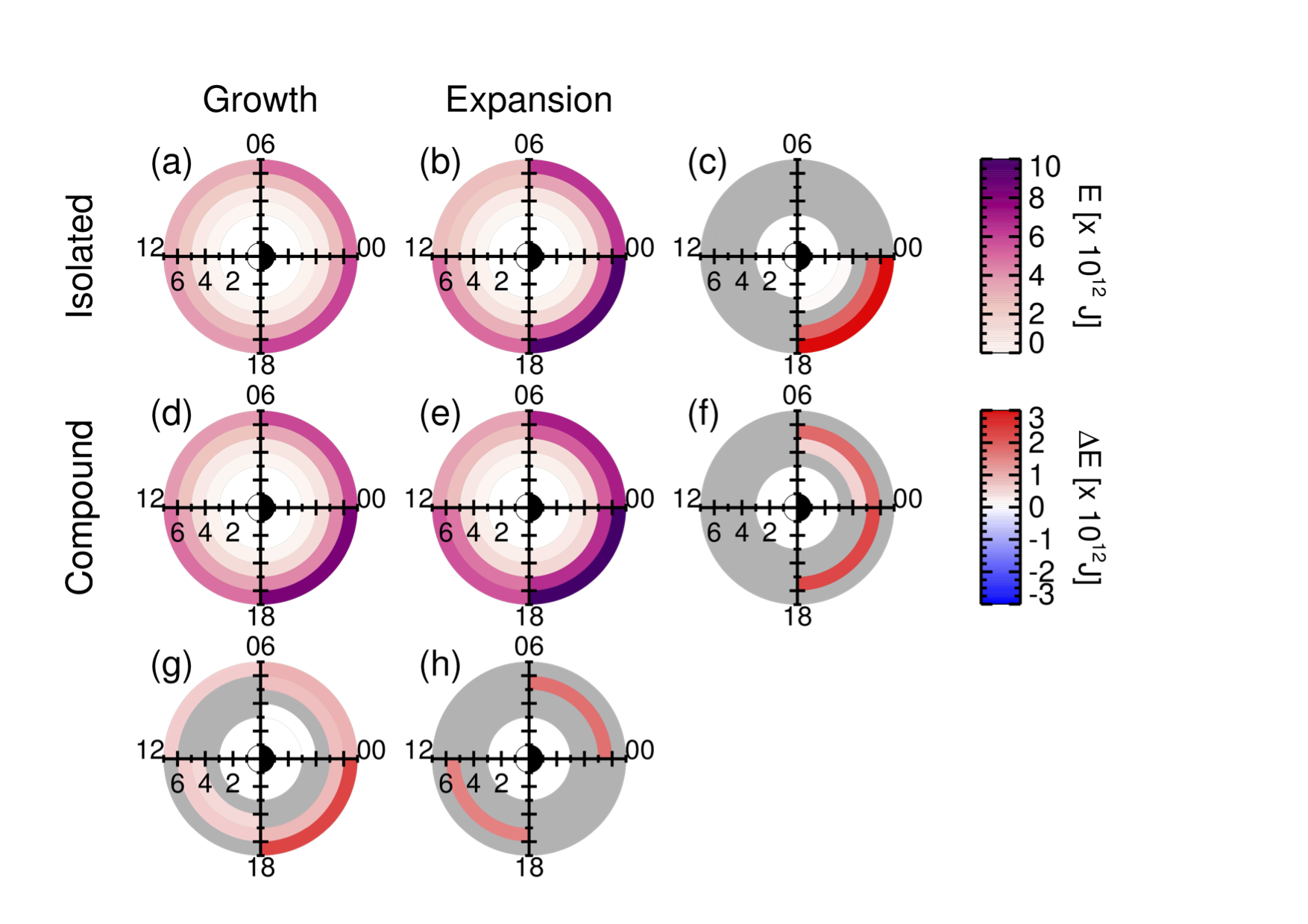
Figure: Values for each L‐MLT bin are plotted at the bins' location in the L‐MLT domain for the H+ ions. The mean energy values, E (J), are shown for (a) growth phases of isolated substorms, (b) expansion phases of isolated substorms, (d) growth phases of compound substorms, and (e) expansion phases of isolated substorms. The difference in the mean values, ΔE (J), for the expansion phase relative to the growth phase is shown for (c) isolated substorms and (f) compound substorms. The difference in mean values for the compound substorms relative to the isolated substorms is shown for (g) the growth phase and (h) the expansion phase. It is noted that, for the difference plots (c, f, g, h), the difference in mean values is only plotted if the distributions are identified to be statistically different according to the Kolmogorov‐Smirnov test with p<0.01. MLT = magnetic local time.